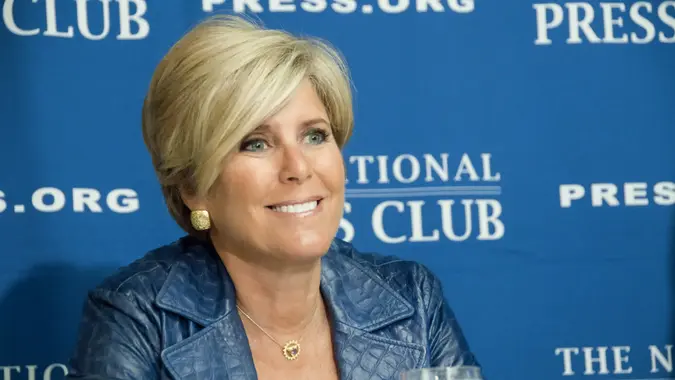7 Positive Signs for Your 401(k) in 2025

Commitment to Our Readers
GOBankingRates' editorial team is committed to bringing you unbiased reviews and information. We use data-driven methodologies to evaluate financial products and services - our reviews and ratings are not influenced by advertisers. You can read more about our editorial guidelines and our products and services review methodology.

20 Years
Helping You Live Richer

Reviewed
by Experts

Trusted by
Millions of Readers
In March, the S&P 500 and Nasdaq both fell into correction territory — a drop of at least 10%.
Investors feel spooked by tariff turmoil, trade wars, geopolitical risk and U.S. stock prices remaining high compared to earnings. Are there any silver linings to all these storm clouds hovering over your 401(k) account?
It turns out that there are, according to these financial experts.
Want to grow your retirement savings? Here’s how to max out your 401(k).
Signs of Resilience in the Economy
The U.S. economy hasn’t collapsed, despite all the uncertainty around trade, tariffs and regulations.
In fact, the unemployment rate remains extremely low at 4.1%, according to the Bureau of Labor Statistics. That’s well under the 5% rate considered full employment and a healthy economy.
Raw jobs data isn’t the only signal of strength, either.
“We’re still seeing companies improving retirement benefits and more workers enrolling in plans with automatic contribution increases,” said Melissa Cox, founder and CFP at Future-Focused Wealth. “Those quiet, behind-the-scenes improvements are setting people up for better long-term outcomes.”
Signaled Tax Cuts
The Trump administration bills itself as business-friendly and has repeatedly stated its goals to cut both corporate and individual income taxes.
For example, on the campaign trail, President Donald Trump proposed cutting the corporate tax rate from 21% to 15%, as outlined by the Committee for a Responsible Federal Budget. He has even floated the idea of eliminating individual income taxes for those earning less than $150,000 per year.
These types of tax changes stimulate the economy, driving higher company profits and stock prices.
Business-Friendly Regulatory Changes
Similarly, the administration has signaled time and again that it plans to reduce regulation to boost business growth.
David Rosenstrock, director at Wharton Wealth Planning, sees this juicing the stock market over the next few years. “Over time, the administration will likely shift its focus from disruptive tariffs to cutting regulations and maintaining tax policies to support economic activity.”
Fed Reducing Quantitative Tightening
To combat inflation, the Federal Reserve started shrinking its balance sheet starting in 2022. The process, known as quantitative tightening or QT, reduces the money supply and credit in the economy.
That can also put downward pressure on stocks. But in March, the Fed announced that it would slow its QT as it keeps an eye on government layoffs and unemployment rates, Reuters reported.
“This helps explain why stocks rose after the Federal Reserve’s March meeting, even though officials indicated that inflation is still above their target and growth is poised to slow,” added Rosenstrock.
Corrections Create Opportunity
When prices drop, buyers get better bargains. It goes for stocks just as much as shopping at retail stores.
“I was raised on the belief that ‘when the stock market drops, opportunity knocks,'” Cox said. “If you’re contributing regularly to your 401(k), you’re buying shares on sale when the market dips. I even encourage clients to consider contributing a little more when the market is down and offering more bang for their buck.”
Higher Contribution Limits
The IRS raised the contribution limits for 401(k) accounts in 2025, from $23,000 to $23,500.
Catch-up contributions for workers aged 50 and over remain at $7,500, for a maximum contribution of $31,000 this year. That can reduce your tax bill by quite a bit, by slimming your modified adjusted gross income (MAGI).
By reducing your MAGI, you can also score better deals on ACA health insurance premiums — all while saving and investing more money for your retirement.
New Rules Allow ‘Enhanced Catch-Up Contributions’
The SECURE 2.0 Act of 2022 created a new limit for older workers aged 60-63, called “enhanced catch-up contributions.”
Starting in 2025, these workers in their early 60s can contribute an extra $11,250 per year to their 401(k), 403(b), 457 plan or Thrift Savings Plan. That lets them contribute a total of $34,750 in 2025.
Over time, the stock market rises as the economy expands. It doesn’t do so every year, of course, but Vince DeCrow of RISE Investments urges investors to take the long view.
“In the 68 years since the S&P 500 became a 500-company index, it posted positive gains in 50 of those years and had 18 down years,” he explained. “The odds are in investors’ favor for the market to keep rising over the long-term.”
 Written by
Written by  Edited by
Edited by 

























